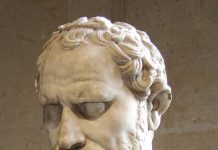One would not expect to find the secret of the universe in a mere novel, but if we read correctly a letter written by the novelist Joseph Conrad in 1898, that is an animating principle of his book The Rescue. He had just witnessed the operation of a Röntgen machine in Glasgow, and it became the prime topic of conversation at dinner that night.
In the evening dinner, X rays, talk about the secret of the universe and the nonexistence
of, so called, matter. The secret of the universe is in the existence of horizontal
waves whose varied vibrations are at the bottom of all states of consciousness.
Hugh Epstein, the author of this book on Joseph Conrad (1857-1924) and Thomas Hardy (1840-1928), makes the point Conrad wrote his 1920 novel The Rescue “with a consciousness of wave theory and its implications for an artistic portrayal of human consciousness.”
Early in the book Epstein sets out the framework for his text: “Hardy, Conrad and the Senses is a discussion of descriptive writing, in which the world is brought to the senses both of the characters in the novels and of the reader. What I show in detail is that Hardy’s and Conrad’s novels create a distinct medium of sensational relations in which the facts of the external world are paramount, but true to the mood in which those facts are apprehended in the route to knowledge of the conditions of existence.” A lofty ambition, in which Epstein largely succeeds. Pitching the idea that both writers are imbued with a sense of cosmic scale, where “nature is massively indifferent to human life and aspirations,” he offers a close reading of a dozen novels where Hardy and Conrad bring a world of illusions “to the test of sensations rather than ideas.” His findings are both remarkable and illuminating.
How they find this illumination in a shadow is a notable revelation of this book. In a footnote on pg. 29, Conrad as quoted as writing in 1921 about the marine paintings of John Everett. “They appeal to me because I have always been alive to the shadow-effects of the sails.” The painting used on the front cover of this book is by Everett, but curiously is not one of his works depicting sails and shadows (one such work is used in this review as a more appropriate choice). As a great example of his interest in shadows on moving ships, Epstein does the reader a great service in quoting a line from Conrad’s manuscript of The Rescue (1920) which was cut from the published book. It is a clear reference to the ‘steady brush’ of an Everett painting
On the clear whiteness of the decks – ruled by straight lines of black pitch
between the narrow planks – the shadows, that in a moving ship are always
so restless and responsive to every slight balancing of the craft lay now
clearly defined as if painted by a steady brush.
In my own reading of Conrad’s famous 1904 novel Nostromo, I noted that Conrad also employs shadows in the sky to achieve his atmospheric effects: “…big white clouds seemed to fall slowly into the darkness of their own shadows.” Although Epstein does not mention Georges Simenon, consider the use of shadows employed just 12 years later in his Maigret novel Liberty Bar: “The railway station at Antibes was bathed in light so intense that the people coming and going were reduced to shadows.” While most authors would describe what can be seen in the light, here we see again a scene being defined by a shadow world.
The passage by Conrad clearly sets an ‘atmosphere’ which is the key word Epstein latches onto to prise open a scientific insight into the works under discussion. “The medium through which things are seen and heard – the so-called ‘atmosphere’ widely praised in both novelists – is entirely of a piece with a physics of electromagnetic fields.”
Hardy also used shadow to great effect in establishing atmosphere in his works. Here is a passage Epstein quotes from Far From the Madding Crowd (1874):
The moon shone to-night, and its light was not of a customary kind. His window
admitted only a reflection of its rays, and the pale sheen had that reverse direction
which snow gives, coming upward and lighting up his ceiling in an unnatural way,
casting shadows in strange places, and putting lights where shadows had used to be.
Even though he does not explore the implications of the words ‘unnatural’ and ‘strange’, Epstein does relate this passage to physics. “This episode is specular, that is, gained only from reflected light. It displays in concentrated form how Hardy’s pictures of people in their moments of crisis keep to surfaces that connect his characters to the forces that surround them.” Epstein makes a more general point in his book as to how the physics of the mid-nineteenth century influenced Hardy:
As the American populariser of science, Edward Youmans, wrote in 1865 of forces,
“the moment they are determined to be indestructible, the investigator becomes
bound to account for them,” which, in its turn, suggests the scientific basis for the
pedantic inductiveness of Hardy’s early style in its compulsion to account for the
transformation of energies as they pass between mental and physical events.
Conrad was quite explicit on this topic, writing that “for me, writing is just simply the conversion of nervous force into phrases.” Epstein discerns a link here specifically with the Second Law of Thermodynamics, which dictates that energy is not lost but constantly transformed or converted. I was surprised Epstein did not explore this further with reference to the philosophy of Michel Serres, who died last year. His philosophy of science was a prime source of the ‘Flaubert and Thermodynamics’ literature of the mid- to late 20th century, which resonates with a further link that Epstein gives us: the English novelist Ford Madox Ford related in his 1924 book about Conrad “That which really brought us together was a devotion to Flaubert.”
In this brief review I will just mention one other key intersection between a Hardy novel and science. It comes in The Return of the Native:
Gusts in innumerable series followed each other from the north-west, and when
each of them raced past the sound of its progress resolved into three. Treble,
tenor, and bass notes were to be found therein.
Epstein writes that this passage “Undoubtedly rests upon a wave theory of sound, such as that proposed by Helmholtz and popularised by Tyndall, in which sound is always conceived of as a motion of the air.” Thoroughly footnoted, and with 20 pages of references, this book will compel readers who thought they were familiar with the works of Hardy and Conrad to read them all over again!
There is a typo on 166 where the author inserts a quote from Conrad’s Heart of Darkness: “in in the air” should be “in the air”. And on pg. 177, the date of Luigi Russolo’s futurist manifesto on music is given as 1911 instead of 1913.
A work of superior erudition, this is an essential text for anyone interested in understanding the books of Hardy and Conrad; and more broadly the state of physics and its interplay with literature in the late 19th and early 20th centuries.
Photo credit: Deck Scene from the ‘Wiscombe Park’ by John Everett, in the collection of The National Maritime Museum, London.
Dr Hugh Epstein is a retired college lecturer and the current Secretary of the Joseph Conrad Society
Hardy, Conrad and the Senses is 80 pounds sterling by Univ. of Edinburgh Press














